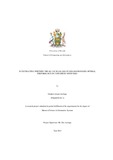| dc.description.abstract | The performance of WLANs has tremendously improved achieving speeds that were only witnessed in the
competing wired networks. This has resulted to the adoption of WLANs in converged networks supporting
both the low and high priority traffic like VoIP. With the voice, video, business data, and background traffic
convergence, a key concern in the WLANs is to offer differentiated services.
Though this can be achieved through the 802.11e QoS standard, it is however done at the expense of lesspriority
traffic such as HTTP and FTP. This research explored the EDCF – the QoS mechanism for WLANs
MAC layer and studied the parameters such as minimum and maximum contention windows (CWmin &
CWmax), arbitration inter-frame spacing (AIFS), and transmission opportunities (TXOP), that are used in the
implementation of the QoS algorithm. This study has demonstrated that if these parameters are not optimally
configured, this can result to starvation of the low-priority traffic.
This research was performed in a simulated WLANs environment using OPNET modeler where three
scenarios with same physical and MAC parameters but varying QoS settings were created. We first
examined the performance of low-priority traffic in a non-QoS enabled network using DCF. We later enabled
QoS using HCF and evaluated the impact of high-priority traffic (with QoS enabled) on low-priority-traffic in
a converged network and finally observed the performance of low-priority traffic after modification of the
HCF settings.
From the results of the simulations, it was observed that the DCF’s overall performance was marginally better
in terms of providing fairness for the transmission of all traffic. Whereas the EDCF performed extremely well
in provision of differentiated services, the low-priority traffic on the other hand considerably suffered from
diminishing resources tending to starvation. This was observed through QoS indicators such as delay, packet
loss, and throughput. | en_US |



